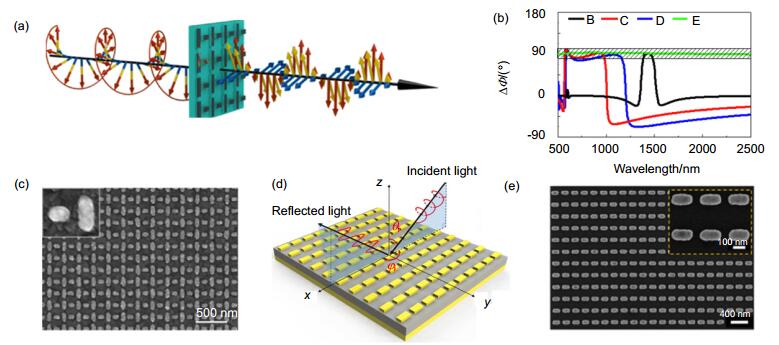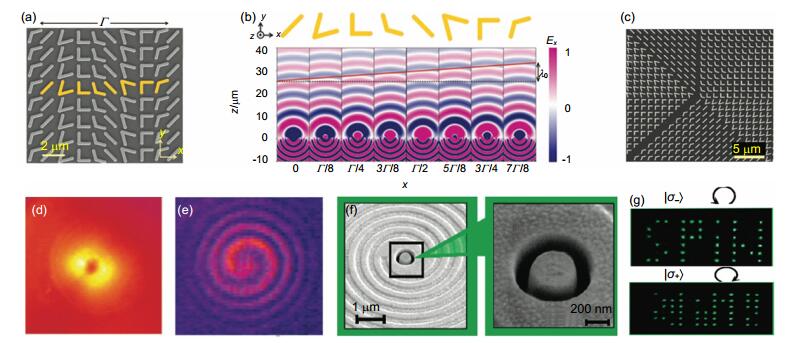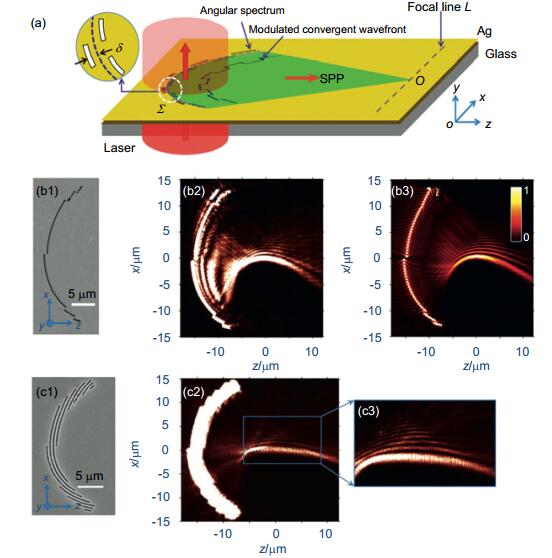-
摘要
传统光学系统(如透镜、波片和全息片等)在光程远大于波长尺度的范围内实现对光波前的调控,其中振幅、相位和偏振的改变均依赖于光束反射、折射和衍射过程所累积的动态光程差。近年来涌现出的平面超薄光学系统因突破了传统设计的局限性而受到各个领域研究人员的青睐。本文着重介绍基于表面等离子激元的超表面在自由空间光场和局域光场波前调控方面的最新进展,阐述相关机理和具体应用,并结合国内外研究现状,分析现有技术存在的瓶颈且对该领域未来的发展趋势进行探讨和展望。
Abstract
Conventional optical systems (lenses, wave-plates and holograms) shape the wavefront of light within the range of an optical path that is much larger than the wavelength of light. The control of amplitude, phase and polarization of light depends on the dynamic optical path difference accumulated through the reflection, refraction and diffraction. Recently, planar ultrathin optical components have attracted tremendous attention by removing such traditional limitations. In this paper, we mainly review the recent progress of plasmonic metasurfaces with respect to wavefront shaping of free space and localized optical fields, including the fundamental mechanisms and applications. Both the drawbacks of existing technology and potential development are highlighted.
-
Key words:
- surface plasmon polaritons /
- metasurfaces /
- wavefront shaping
-
Overview

Abstract:Organic light emitting devices (OLEDs) have some performances, such as low power consumption, ultra-light, fast response speed, high-definition, self-luminous and viewing angle, etc, which are expected to become a mainstream of the next generation of display devices. It is found that the microcavity structure can narrow the luminescence spectrum of the thin film and improve the luminescence color purity of the device effectively. We prepared a light-emitting device by using high vacuum deposition process and high-precision film thickness detector. This paper designed and prepared the green OLED devices based on double metallic mirrors in microcavity structures, of which the process was by vacuum evaporation and double metallic mirrors of devices: Al/MO3 as device of anode and hole injection layer, and LiF/Al as device cathode and electron injection layers. Organic material C545T was as green microcavity device of light-emitting materials. The device structure is Al(20 nm)/MoO3(4 nm)/2T-NATA(10 nm)/NPB(15 nm)/NPB:C545T(x%, 20 nm)/Alq3: C545T (4%, 20 nm)/Bphen (35 nm)/LiF(1 nm)/Al(200 nm), where x is the doping concentration, denoted as device B1. In order to analyze the microcavity effect, another preparation was made based on the ITO reference device B2. The microcavity effect of the device was analyzed by comparing the device's luminous brightness, luminous efficiency and luminescent color purity. The experimental results show that the device has the best optical and electrical properties when the doping concentration of device B1 is 3%. We found B1 and B2 color coordinates, (0.289, 0.620) and (0.317, 0.557), respectively. It can be judged that the luminescent color of the microcavity device B1 is purer. Then, microcavity device for microcavity effects could improve forward direction luminance intensity and luminance efficiency. At 100 mA/cm2, the brightness of devices B1 and B2 are 5076 cd/m2and 4818 cd/m2, and the maximum brightness of the both devices are 9277.7 cd/m2 and 10440 cd/m2. At 100 mA/cm2, luminance efficiencies of devices B1 and B2 are 6.0 cd/A and 5.61 cd/A, and the maximum luminance efficiencies of the both devices were 8.6 cd/A and 7.97 cd/A. We can conclude that, compared with the reference device, the green microcavity device has better luminous efficiency and color purity than the reference device under the effect of the microcavity, and the photoelectric performance of the device is best when the C545T doping concentration is 3% and the thickness is 20 nm.
-

-
图 1 (a) T型纳米天线实现四分之一波片原理图[18]. (b)正交方向线偏振光的相位差随波长变化关系,其中B, C, D, E分别代表四组不同结构参数条件,B代表金属棒几何尺寸为lx=160 nm,ly=160 nm,z=8 nm,C代表金属棒几何尺寸为lx=60 nm,ly=160 nm,z=45 nm,D代表金属棒几何尺寸为lx=60 nm,ly=240 nm,z=50 nm,E代表金属棒几何尺寸为lx=10 nm,ly=160 nm,z=60 nm,以上宽度均为w=20 nm,空隙g=10 nm[18]. (c) T型纳米天线扫描电子显微镜图[18]. (d) MIM反射型超表面实现广角四分之一波片[19]. (e)基本单元纳米棒电子显微镜图[19].
Figure 1. (a) Schematic of quarter waveplate achieved by T-type nanoantennas [18]. (b) Phase shift of orthogonal linearly polarization light as a function of wavelength [18]. The B-line represents the structural parameters of lx=160 nm, ly=160 nm and z=8 nm. The C-line represents the structural parameters of lx=60 nm, ly=160 nm and z=45 nm. The D-line represents the structural parameters of lx=60 nm, ly=240 nm and z=50 nm. The E-line represents the structural parameters of lx=10 nm, ly=160 nm and z=60 nm. The width of nanoantenna is 20 nm and the gap is 10 nm. (c) Scanning electron microscope (SEM) images of interleaved nanoantennas [18]. (d) Schematic of metal-insulator-metal (MIM) reflective metasurfaces with broadband angles [19]. (e) SEM images of the typical unit cells in (d). The overview scale bar is 400 nm and the inserted scale bar is 100 nm [19].
图 2 (a) Ⅴ型纳米天线的电子显微镜图片[25]. (b)图中黄色标注的结构对应八阶离散化的相位值[25]. (c)用于产生涡旋光的超表面电子显微镜图片[25]. (d)实验探测得到的一阶涡旋光强度图[25]. (e)涡旋光与同轴高斯光干涉实验图[25]. (f)手性依赖的金属螺旋线结构的电子显微镜图[29]. (g)不同自旋偏振态与超表面相互作用后的透射图[29].
Figure 2. (a) Scanning electron microscope (SEM) images of Ⅴ-antenna array [25]. (b) The representative Ⅴ-antenna nanostructures corresponding to eight discretized phase difference [25]. (c) SEM images of a plasmonic interface that creates an optical vortex [25]. (d) The measured far-field intensity distribution of an optical vortex with topological charge one [25]. (e) The measured spiral pattern created by the interference of vortex beam and co-propagating Gaussian beam [29]. (f) The magnified SEM image of spiral corrugations of spin-dependent transmission [29]. (g) The differently measured light transmissions for |σ-〉 and |σ+〉 illuminations [29].
图 3 (a) 用于实现径向光偏振片与叉型分光光栅相结合的超表面电子显微镜图[30]. (b) 633 nm和850 nm圆偏振光入射后获得径向偏振光的实验结果[30]. (c)矢量光操控的实验测试原理图[30]. (d) 5种不同轨道角动量实验检测结果图,左图为同心金属圆环结构探测结果,右图为平面叉型超表面探测结果,两种办法均具有区分5种携带不同拓扑荷数的涡旋光的能力[35]. (e)手性依赖的异常透射“超孔径”原理图[36]. (f)具有手性选择性的“超孔径”的透过光谱[36].
Figure 3. (a) The fabricated structure for generating a radially polarized beam [30]. (b) The measured far-field intensity distributions at the wavelengths of 633 nm and 850 nm [30]. (c) The experimental setup [30]. (d) Detected photocurrent as functions of incident polarization and orbit angular momentum [35]. (e) Schematic of chiral meta-aperture [36]. (f) The measured transmission spectra for both left and right handed circularly polarized light [36].
图 4 (a) 基于传播型SPP产生的无衍射光束的近场光学表征的实验结果图[55],图中SPP传播距离达到80 μm. (b)通过调控交叉型金属线栅获得纳米级光学空隙,实验中观测到近似Talbot效应的结果[56].
Figure 4. (a) The near-field intensity distribution of localized Cosine-Gaussian beam observed by a near-field scanning optical microscope. The propagating length is 80 μm [55]. (b) The plasmonic voids achieved by interleaved metal gratings. Talbot effect is observed [56].
图 5 (a) 在金属光栅一侧加工的辅助结构与SPP表面波发生相消干涉从而实现SPP单向激发的实验结果图[57]. (b)通过调控金属狭缝的线宽和深度来实现表面波的相消干涉所获得的单向激发模拟结果图[58]. (c)可重构偏振调控型的超表面原理图[59]. (d), (e)实验表征右旋偏振光实现向右侧激发SPP而左旋偏振光实现向左侧激发SPP的结果图[59].
Figure 5. (a) The experimental result of unidirectional nanoslit coupler for surface plasmons [57]. (b) The numerical simulation of compact antenna for unidirectional launching and decoupling of surface plasmons [58]. (c) Schematic of polarization-controllable tunable directional coupling metasurfaces [59]. (d), (e) Near-field scanning optical microscope image of the metasurface under chiral illuminations [59].
图 6 (a) 二维平面SPP表面波傅里叶变换原理图[61]. (b1)~(b3)分别是金属表面实现Weber光束的加工结构图、近场光学表征图以及计算模拟图[61]. (c1)~(c3)分别是金属表面实现Airy光束的加工结构图、近场光学表征图以及局部区域放大图像[61].
Figure 6. (a) Schematic of in-plane Fourier transform for generating a converging SPP [61]. (b1)~(b3) represent the fabricated structures of scanning electron microscope (SEM) image, intensity distribution observed by a near-field scanning optical microscope (NSOM) and numerical simulation of plasmoic Weber beam, respectively [61]. (c1)~(c3) represent the fabricated structures of plasmonic Airy beam generator, the NSOM measurement result and zoom-in view of blue box, respectively [61].
-
参考文献
[1] Chen P Y, Soric J, Alù A. Invisibility and cloaking based on scattering cancellation[J].Advanced Materials, 2012, 24(44): OP281-OP304. https://www.researchgate.net/publication/232320825_Invisibility_and_Cloaking_Based_on_Scattering_Cancellation
[2] Ni Xingjie, Wong Zijing, Mrejen M, et al. An ultrathin invisibility skin cloak for visible light[J]. Science, 2015, 349(6254): 1310- 1314. doi: 10.1126/science.aac9411
[3] Liu Wei, Zhang Jianfa, Lei Bing, et al. Invisible nanowires with interfering electric and toroidal dipoles[J]. Optics Letters, 2015, 40(10): 2293-2296. doi: 10.1364/OL.40.002293
[4] Valentine J, Zhang Shuang, Zentgraf T, et al. Three-dimensional optical metamaterial with a negative refractive index[J]. Nature, 2008, 455(7211): 376-379. doi: 10.1038/nature07247
[5] Pendry J B. Negative refraction makes a perfect lens[J]. Physical Review Letters, 2000, 85(18): 3966-3969. doi: 10.1103/PhysRevLett.85.3966
[6] Wu Aimin, Li Hao, Du Junjie, et al. Experimental demonstration of in-plane negative-angle refraction with an array of silicon nanoposts[J]. Nano Letters, 2015, 15(3): 2055-2060. doi: 10.1021/nl5049516
[7] Shalaev V. Optical negative-index metamaterials[J]. Nature Photonics, 2007, 1(1): 41-48. doi: 10.1038/nphoton.2006.49
[8] Genov D A, Zhang Shuang, Zhang Xiang. Mimicking celestial mechanics in metamaterials[J].Nature Physics, 2009, 5(9): 687-692. doi: 10.1038/nphys1338
[9] Echtermeyer T J, Milana S, Sassi U, et al. Surface plasmon polariton graphene photodetectors[J]. Nano Letters, 2016, 16(1): 8-20. doi: 10.1021/acs.nanolett.5b02051
[10] Demetriadou A, Kornyshev A A. Principles of nanoparticle imaging using surface plasmons[J].New Journal of Physics, 2015, 17: 013041. doi: 10.1088/1367-2630/17/1/013041
[11] Alizadeh M H, Reinhard B M. Enhanced optical chirality through locally excited surface plasmon polaritons[J]. ACS Photonics, 2015, 2(7): 942-949. doi: 10.1021/acsphotonics.5b00151
[12] Zhang Haochi, Fan Yifeng, Guo Jian, et al. Second-harmonic generation of spoof surface plasmon polaritons using nonlinear plasmonic metamaterials[J]. ACS Photonics, 2016, 3(1): 139- 146. doi: 10.1021/acsphotonics.5b00580
[13] Ebbesen T W, Lezec H J, Ghaemi H F, et al. Extraordinary optical transmission through sub-wavelength hole arrays[J]. Nature, 1998, 391(6668): 667-669. doi: 10.1038/35570
[14] Weiner J. The physics of light transmission through subwavelength apertures and aperture arrays[J]. Reports on Progress in Physics, 2009, 72(6): 064401. doi: 10.1088/0034-4885/72/6/064401
[15] Johns P, Yu Kuai, Devadas M S, et al. Role of resonances in the transmission of surface plasmon polaritons between nanostructures[J]. ACS Nano, 2016, 10(3): 3375-3381. doi: 10.1021/acsnano.5b07185
[16] Wang Qianjin, Li Jiaqi, Huang Chengping, et al. Enhanced optical transmission through metal films with rotation- symmetrical hole arrays[J]. Applied Physics Letters, 2005, 87(9): 091105. doi: 10.1063/1.2034120
[17] Glybovski S B, Tretyakov S A, Belov P A, et al. Metasurfaces: from microwaves to visible[J]. Physics Reports, 2016, 634: 1-72. doi: 10.1016/j.physrep.2016.04.004
[18] Zhao Yang, Alù A. Tailoring the dispersion of plasmonic nanorods to realize broadband optical meta-waveplates[J]. Nano Letters, 2013, 13(3): 1086-1091. doi: 10.1021/nl304392b
[19] Jiang Zhihao, Lin Lan, Ma Ding, et al. Broadband and wide field-of-view plasmonic metasurface-enabled waveplates[J]. Scientific Reports, 2014, 4: 7511.
[20] Jahani S, Jacob Z. All-dielectric metamaterials[J]. Nature Nanotechnology, 2016, 11(1): 23-36. doi: 10.1038/nnano.2015.304
[21] Yang Yuanmu, Kravchenko I I, Briggs D P, et al. All-dielectric metasurface analogue of electromagnetically induced transparency[J]. Nature Communications, 2014, 5: 5753. doi: 10.1038/ncomms6753
[22] Paniagua-Domínguez R, Yu Yefeng, Miroshnichenko A E, et al. Generalized brewster effect in dielectric metasurfaces[J]. Nature Communications, 2016, 7: 10362. doi: 10.1038/ncomms10362
[23] Dai Yanmeng, Ren Wenzhen, Cai Hongbing, et al. Realizing full visible spectrum metamaterial half-wave plates with patterned metal nanoarray/insulator/metal film structure[J]. Optics Express, 2014, 22(7): 7465-7472. doi: 10.1364/OE.22.007465
[24] Pors A, Nielsen M G, Bozhevolnyi S I. Broadband plasmonic half-wave plates in reflection[J]. Optics Letters, 2013, 38(4): 513-515. doi: 10.1364/OL.38.000513
[25] Yu Nanfang, Genevet P, Kats M A, et al. Light propagation with phase discontinuities: generalized laws of reflection and refraction[J]. Science, 2011, 334(6054): 333-337. doi: 10.1126/science.1210713
[26] Gorodetski Y, Niv A, Kleiner V, et al. Observation of the spin-based plasmonic effect in nanoscale structures[J]. Physical Review Letters, 2008, 101(4): 043903. doi: 10.1103/PhysRevLett.101.043903
[27] Bliokh K Y, Gorodetski Y, Kleiner V, et al. Coriolis effect in optics: unified geometric phase and spin-hall effect[J]. Physical Review Letters, 2008, 101(3): 030404. doi: 10.1103/PhysRevLett.101.030404
[28] Shitrit N, Bretner I, Gorodetski Y, et al. Optical spin hall effects in plasmonic chains[J]. Nano Letters, 2011, 11(5): 2038-2042. doi: 10.1021/nl2004835
[29] Gorodetski Y, Shitrit N, Bretner I, et al. Observation of optical spin symmetry breaking in nanoapertures[J]. Nano Letters, 2009, 9(8): 3016-3019. doi: 10.1021/nl901437d
[30] Lin Jiao, Genevet P, Kats M A, et al. Nanostructured holograms for broadband manipulation of vector beams[J]. Nano Letters, 2013, 13(9): 4269-4274. doi: 10.1021/nl402039y
[31] Tan P S, Yuan X C, Lin J, et al. Surface plasmon polaritons generated by optical vortex beams[J]. Applied Physics Letters, 2008, 92(11): 111108. doi: 10.1063/1.2890058
[32] Tan P S, Yuan X C, Lin J, et al. Analysis of surface plasmon interference pattern formed by optical vortex beams[J]. Optics Express, 2008, 16(22): 18451-18456. doi: 10.1364/OE.16.018451
[33] Zhan Qiwen. Cylindrical vector beams: from mathematical concepts to applications[J].Advances in Optics and Photonics, 2009, 1(1): 1-57. doi: 10.1364/AOP.1.000001
[34] Willner A E, Huang F, Yan Y, et al. Optical communications using orbital angular momentum beams[J]. Advances in Optics and Photonics, 2015, 7(1): 66-106. doi: 10.1364/AOP.7.000066
[35] Genevet P, Lin Jiao, Kats M A, et al. Holographic detection of the orbital angular momentum of light with plasmonic photodiodes[J]. Nature Communications, 2012, 3: 1278. doi: 10.1038/ncomms2293
[36] Du Luping, Kou Shanshan, Balaur E, et al. Broadband chirality-coded meta-aperture for photon-spin resolving[J]. Nature Communications, 2015, 6: 10051. doi: 10.1038/ncomms10051
[37] Wang Xiaoli, Tang Zhiyong. Circular dichroism studies on plasmonic nanostructures[J].Small, 2017, 13(1): 1601115. doi: 10.1002/smll.v13.1
[38] Deng Haidong, Chen Xingyu, Xu Yi, et al. Single protein sensing with asymmetric plasmonic hexamer via fano resonance enhanced two-photon luminescence[J]. Nanoscale, 2015, 7(48): 20405-20413. doi: 10.1039/C5NR04118J
[39] Neugebauer M, Woźniak P, Bag A, et al. Polarization-controlled directional scattering for nanoscopic position sensing[J]. Nature Communications, 2016, 7: 11286. doi: 10.1038/ncomms11286
[40] Wei Shibiao, Lei Ting, Du Luping, et al. Sub-100nm resolution PSIM by utilizing modified optical vortices with fractional topological charges for precise phase shifting[J]. Optics Express, 2015, 23(23): 30143-30148. doi: 10.1364/OE.23.030143
[41] Liu Zhaowei, Wei Qihuo, Zhang Xiang. Surface plasmon interference nanolithography[J].Nano Letters, 2005, 5(5): 957- 961. doi: 10.1021/nl0506094
[42] Tame M S, McEnery K R, Özdemir Ş K, et al. Quantum plasmonics[J]. Nature Physics, 2013, 9(6): 329-340. doi: 10.1038/nphys2615
[43] Tetienne J P, Lombard A, Simpson D A, et al. Scanning nanospin ensemble microscope for nanoscale magnetic and thermal imaging[J]. Nano Letters, 2016, 16(1): 326-333. doi: 10.1021/acs.nanolett.5b03877
[44] Ciraci C, Hill R T, Mock J J, et al. Probing the ultimate limits of plasmonic enhancement[J]. Science, 2012, 337(6098): 1072- 1074. doi: 10.1126/science.1224823
[45] Ye Jian, Wen Fangfang, Sobhani H, et al. Plasmonic nanoclusters: near field properties of the fano resonance interrogated with SERS[J]. Nano Letters, 2012, 12(3): 1660- 1667. doi: 10.1021/nl3000453
[46] Urban M J, Zhou Chao, Duan Xiaoyang, et al. Optically resolving the dynamic walking of a plasmonic walker couple[J]. Nano Letters, 2015, 15(12): 8392-8396. doi: 10.1021/acs.nanolett.5b04270
[47] Mühlenbernd H, Georgi P, Pholchai N, et al. Amplitude- and phase-controlled surface plasmon polariton excitation with metasurfaces[J]. ACS Photonics, 2016, 3(1): 124-129. doi: 10.1021/acsphotonics.5b00536
[48] O'Connor D, Ginzburg P, Rodríguez-Fortuño F J, et al. Spin-orbit coupling in surface plasmon scattering by nanostructures[J]. Nature Communications, 2014, 5: 5327. doi: 10.1038/ncomms6327
[49] Gubbin C R, Martini F, Politi A, et al. Strong and coherent coupling between localized and propagating phonon polaritons[J]. Physical Review Letters, 2016, 116(24): 246402. doi: 10.1103/PhysRevLett.116.246402
[50] Xu Ting, Wang Changtao, Du Chunlei, et al. Plasmonic beam deflector[J]. Optics Express, 2008, 16(7): 4753-4759. doi: 10.1364/OE.16.004753
[51] 赵泽宇, 蒲明博, 王彦钦, 等.广义折反射定律[J].光电工程, 2017, 44(2): 129-139. http://www.oee.ac.cn/CN/abstract/abstract1889.shtml
Zhao Zeyu, Pu Mingbo, Wang Yanqin, et al. The generalized laws of refraction and reflection[J].Opto-Electronic Engineering, 2017, 44(2): 129-139. http://www.oee.ac.cn/CN/abstract/abstract1889.shtml
[52] Chen Houtong, Taylor A J, Yu Nanfang. A review of metasurfaces: physics and applications[J]. Reports on Progress in Physics, 2016, 79(7): 076401. doi: 10.1088/0034-4885/79/7/076401
[53] Zhang Lei, Mei Shengtao, Huang Kun, et al. Advances in full control of electromagnetic waves with metasurfaces[J]. Advanced Optical Materials, 2016, 4(6): 818-833. doi: 10.1002/adom.v4.6
[54] Lin Jiao, Dellinger J, Genevet P, et al. Cosine-gauss plasmon beam: a localized long-range nondiffracting surface wave[J]. Physical Review Letters, 2012, 109(9): 093904. doi: 10.1103/PhysRevLett.109.093904
[55] Wei Shibiao, Lin Jiao, Wang Qian, et al. Singular diffraction-free surface plasmon beams generated by overlapping phase-shifted sources[J]. Optics Letters, 2013, 38(7): 1182-1184. doi: 10.1364/OL.38.001182
[56] Wei Shibiao, Lin Jiao, Wang Rong, et al. Self-imaging generation of plasmonic void arrays[J]. Optics Letters, 2013, 38(15): 2783-2785. doi: 10.1364/OL.38.002783
[57] López-Tejeira F, Rodrigo S G, Martín-Moreno L, et al. Efficient unidirectional nanoslit couplers for surface plasmons[J]. Nature Physics, 2007, 3(5): 324-328. doi: 10.1038/nphys584
[58] Baron A, Devaux E, Rodier J C, et al. Compact antenna for efficient and unidirectional launching and decoupling of surface plasmons[J]. Nano Letters, 2011, 11(10): 4207-4212. doi: 10.1021/nl202135w
[59] Lin Jiao, Mueller J P B, Wang Qian, et al. Polarization-controlled tunable directional coupling of surface plasmon polaritons[J]. Science, 2013, 340(6130): 331-334. doi: 10.1126/science.1233746
[60] Lin Jiao, Wang Qian, Yuan Guanghui, et al. Mode-matching metasurfaces: coherent reconstruction and multiplexing of surface waves[J]. Scientific Reports, 2015, 5(1): 10529. https://arxiv.org/pdf/1405.4952v1
[61] Kou Shanshan, Yuan Guanghui, Wang Qian, et al. On-chip photonic fourier transform with surface plasmon polaritons[J]. Light: Science & Applications, 2016, 5: e16034. http://dx.doi.org/10.1038/lsa.2016.34
-
访问统计


 E-mail Alert
E-mail Alert RSS
RSS

 下载:
下载:








